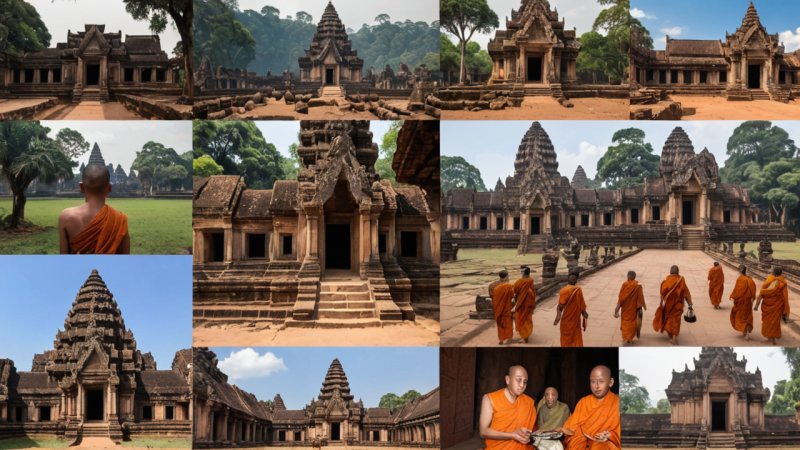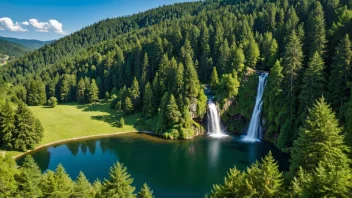Asia, a continent rich in culture and history, is home to some of the world's most famous historical landmarks. Yet, beyond the well-trodden paths of the Great Wall of China or the Taj Mahal, lie hidden gems waiting to be discovered. These lesser-known historical sites offer a glimpse into the diverse heritage of the continent, showcasing unique architecture, ancient traditions, and stories that have shaped the region over centuries. In this article, we will explore some of Asia's hidden historical landmarks, providing insights into their significance and tips for visiting.
The Enigmatic Ruins of Angkor Borei, Cambodia
While Angkor Wat is the crown jewel of Cambodia, a lesser-known site, Angkor Borei, is equally captivating. Situated near the Mekong River, this ancient city was once a thriving center of the Funan Kingdom, dating back to the 1st century. The remnants of brick temples, pottery, and stone inscriptions provide a fascinating glimpse into early Khmer civilization.
Exploring Angkor Borei
Visitors can wander through the ruins, which are less crowded than those at Angkor Wat, allowing for a more intimate experience with history. The nearby museum houses artifacts discovered at the site, offering context and deeper understanding of the Funan era.
Travel Tips
- Best Time to Visit: The dry season, from November to February, is ideal for exploring the ruins.
- Getting There: Angkor Borei is a short drive from the town of Takeo, easily accessible by tuk-tuk.
- Guided Tours: Consider hiring a local guide to provide insights into the historical significance of the site.
The Ancient Village of Hahoe, South Korea
Nestled in the countryside of South Korea, Hahoe Folk Village is a UNESCO World Heritage site that provides a living glimpse into the country’s Confucian culture. Established during the Joseon Dynasty, the village is known for its preserved traditional houses and scenic surroundings.
Cultural Significance
Hahoe is not just a historical site; it is a vibrant community where cultural practices are still observed. The village hosts the Hahoe Mask Dance Festival, showcasing traditional performances that have been passed down through generations.
Visitor Experience
- Accommodations: Stay in a traditional hanok (Korean house) for an authentic experience.
- Exploring the Village: Take a guided walking tour to learn about the architecture and history of the houses.
- Participate in Festivals: Align your visit with the mask dance festival to immerse yourself in local culture.
The Forgotten Temples of Bagan, Myanmar
Bagan is often overshadowed by its more famous counterparts but boasts thousands of ancient temples scattered across its plains. While many tourists flock to Shwedagon Pagoda, Bagan offers a treasure trove of lesser-known temples, such as the Ananda Temple and the Sulamani Temple.
Temple Hopping
The beauty of Bagan lies in its vastness; visitors can explore hundreds of temples without the crowds. Each temple has unique architectural features and intricate murals that tell the story of the city’s glorious past.
Tips for Visiting Bagan
- Best Time to Visit: The cooler months from November to February offer pleasant weather for exploring.
- Transportation: Rent a bicycle or e-bike to easily navigate the expansive area.
- Sunrise and Sunset: Visit a temple during sunrise or sunset for breathtaking views of the landscape.
The Ruins of Fatehpur Sikri, India
Located near Agra, Fatehpur Sikri is a stunning example of Mughal architecture and was once the capital of the Mughal Empire. This historical site often gets overshadowed by the nearby Taj Mahal, yet it offers a wealth of history and architectural beauty.
Exploring Mughal Heritage
The complex features various structures, including the stunning Buland Darwaza and the intricate marble tomb of Salim Chishti. The architectural style reflects a blend of Persian, Indian, and Islamic influences, making it a unique historical site.
Visiting Tips
- Timing: Visit early in the morning to avoid crowds and enjoy the serene atmosphere.
- Guided Tours: Hiring a guide can enhance your understanding of the historical significance of the site.
- Nearby Attractions: Combine your visit with a trip to the Taj Mahal for a full day of Mughal history.
The Mystical City of Luang Prabang, Laos
Luang Prabang, a UNESCO World Heritage site, is known for its well-preserved architecture and a blend of traditional Lao and French colonial styles. The city is often considered the cultural heart of Laos, offering a mix of stunning temples, vibrant markets, and breathtaking natural scenery.
Cultural Experiences
Visitors can participate in the daily alms-giving ceremony, where monks collect food offerings from locals and tourists. This spiritual practice reflects the deep-rooted Buddhist traditions in the region.
Travel Tips for Luang Prabang
- Best Time to Visit: The dry season from November to March is ideal for exploring.
- Local Cuisine: Don’t miss trying local dishes at the night market, including Laap and Khao Soi.
- Temples to Visit: Be sure to visit Wat Xieng Thong and Wat Mai for their stunning architecture and historical significance.
Conclusion
Asia is a continent filled with hidden historical landmarks that tell the stories of ancient civilizations, cultural evolution, and architectural marvels. From the ruins of Angkor Borei in Cambodia to the enchanting village of Hahoe in South Korea, each site offers a unique perspective on the rich tapestry of Asian history. By venturing off the beaten path, travelers can uncover these hidden gems and gain a deeper appreciation for the diverse cultures that shape this fascinating continent. Whether you are a history buff, culture enthusiast, or simply an adventurous traveler, exploring these lesser-known landmarks will enrich your journey through Asia.






